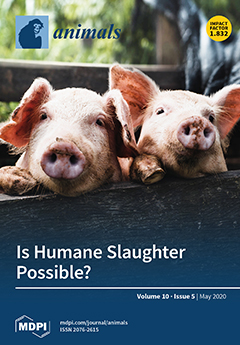This study was conducted to investigate the effect of using cassava residue to replace crushed maize on in vitro fermentation characteristics of dairy cows at mid-lactation and provide guidance for its utilization. The study included seven treatments with four replicates, which used 0% (control, CON), 5%, 10%, 15%, 20%, 25% and 30% cassava residue to replace crushed maize (air-dried matter basis), respectively. A China-patented automated trace gas recording system was used to perform in vitro gas tests; rumen fluids were collected from three dairy cows at mid-lactation. In vitro dry matter digestibility (IVDMD), gas production (GP), pH, ammonia–N (NH
3-N) and microbial protein (MCP) content were analyzed after in vitro incubating for 3, 6, 12, 24 and 48 h, respectively; volatile fatty acid (VFA) content was analyzed after in vitro culturing for 48 h. The results showed that with the increase of substitution ratio of cassava residue, the asymptotic gas production (A) increased quadratically (
p < 0.05), cumulative gas production at 48 h (GP
48) and the maximum rate of substrate digestion (RmaxS) increased linearly and quadratically (
p < 0.05), the time at which the maximum gas production rate is reached (TRmaxG) increases linearly (
p < 0.05). In addition, asymptotic gas production in 30% was significantly higher than the other treatments (
p < 0.05), RmaxS in 25% and 30% were significantly higher than CON, 5% and 10% (
p < 0.05). In addition, with the increase of substitution ratio of cassava residue, when in vitro cultured for 6 h and 12 h, NH
3–N content decreased linearly and quadratically (
p < 0.05). NH
3–N content in 30% was significantly lower than the other treatments except 20% and 25% (
p < 0.05) after cultivating for 6 h. Moreover, the content of iso-butyrate, iso-valerate, valerate and total VFA (tVFA) decreased linearly and quadratically (
p < 0.05), acetate decreased quadratically (
p < 0.05) with the increase of substitution ratio of cassava residue. In conclusion, when the cassava residue substitution ratio for crushed maize was 25% or less, there were no negative effects on in vitro ruminal fermentation characteristics of dairy cows at mid-lactation.
Full article






